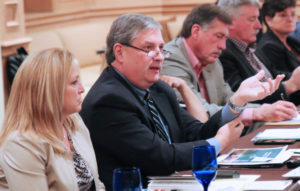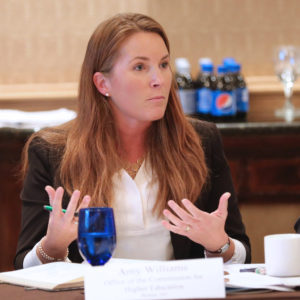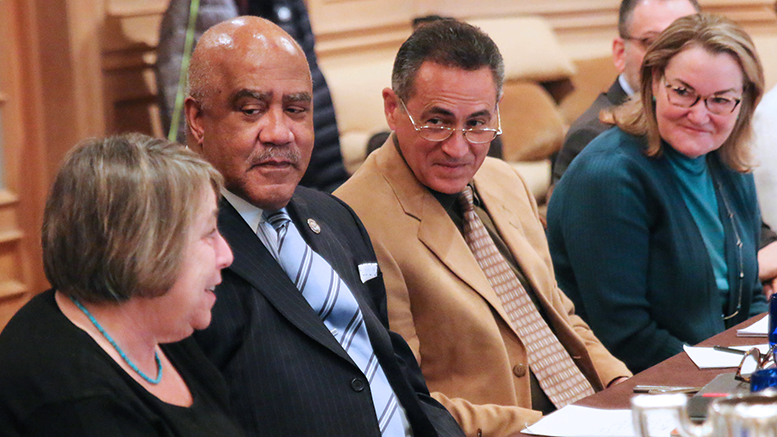A former U.S. education undersecretary who now heads the College Promise Campaign says Promise partnerships should consider serving students in apprenticeships and dual-enrollment programs.
Promise programs — which typically provide the first two years of community college tuition-free for qualifying students — come in myriad forms, and are now even serving adult students in addition to traditional-age college students, so it’s time to consider also including students in dual-enrollment and apprenticeships, said Executive Director Martha Kanter, who served as a community college chancellor in California before joining the Education Department.
“That’s an opportunity that we can work on together,” said Kanter, who spoke Monday at a meeting set by the American Association of Community Colleges and AASA, The School Superintendents Association, in Washington, D.C., to discuss dual credit and college and career readiness.
Kanter noted that Promise programs are now expanding to serve part-time students, such as a recently passed Promise program in San Francisco. She also highlighted efforts at the College of the Canyons in California, where students in apprenticeship programs can transfer earned credits toward applied bachelor’s degrees.
“It’s a pipeline program,” said Kanter, noting that high-demand fields are prime for apprenticeships.
Kanter made her comments during the start of national Apprenticeship Week. The Trump administration has focused on using apprenticeships and similar workforce education programs to prepare students for in-demand jobs. On Monday, the U.S. Labor Department convened the first meeting of its blue-ribbon Task Force on Apprenticeship Expansion, on which AACC President Walter Bumphus serves.
Expanding the use of apprenticeships is also supported by many Republicans and Democrats in Congress. The Obama administration previously also recommended expanding apprenticeships into fields that typically don’t offer them, such as health care and information technology.
Preparing teachers
Attendees at Monday’s meeting, which included mostly community college presidents and school superintendents, also shared ideas to overcome challenges facing dual enrollment. One of them is ensuring that dual-enrollment teachers are properly credentialed. All regional accrediting agencies now or so will require that high school instructors teaching college-level courses through dual enrollment have at least a master’s degree in that discipline or a master’s degree and 18 graduate hours in the discipline.

John Newby of Ivy Tech Community College in Indiana discusses challenges to dual enrollment in his state.
That’s a problem for many states such as Indiana, which doesn’t have enough teachers who meet the requirement. At one time, all teachers in the state were required to have at least a master’s degree — which also came with a pay-scale bump, noted John Newby, assistant vice president of K-12 initiative at Ivy Tech Community College. Today, master’s degrees are not required to teach in Indiana, and those who do have them don’t get a scaled pay increase.
In addition, many of teachers who do have master’s degree or higher are preparing for retirement.
Indiana did receive a waiver to postpone the dual-enrollment teaching requirements until 2022, noted Wendy McNamara, director of an early college high school program at Ivy Tech’s Evansville Campus who is also a state representative. In the meantime, educators and other stakeholders are mulling how to attract more teachers to earn a higher degree. Among the ideas, school districts could: offer stipends to teachers to peruse a master’s degree; cover teachers’ cost for books and fees; and share teachers who already met the requirements.
Tapping various sources

Amy Williams of Montana’s Office of the Commissioner of Higher Education highlights the state’s innovative efforts to encourage more teachers to earn master’s degrees in order to teach dual-enrollment courses.
Montana is also tackling the issue of making sure its dual-enrollment teachers meet accreditation requirements, said Amy Williams, manger of dual enrollment and the Big Sky Pathways program at the state’s Office of the Commissioner of Higher Education. The state last year completed a two-year pilot program that covered the tuition of qualifying high school teachers to earn a master’s degree through the Montana State University system or a tribal college. Teachers earned a voucher for each credit of concurrent enrollment taught; they could use the voucher themselves or transfer it to a colleague.
The state also tapped federally funded programs for teacher education, including the Perkins Rural Reserve Fund to award grants to three career and technical education teachers, and Title IIA, which allowed teachers from 29 schools to receive free or low-cost training/graduate credit.
Attendees of the two-day AACC/AASA meeting also discussed transferability of dual-enrollment credits to four-year colleges; models to fund programs; and building a college-going environment and culture at high schools.

